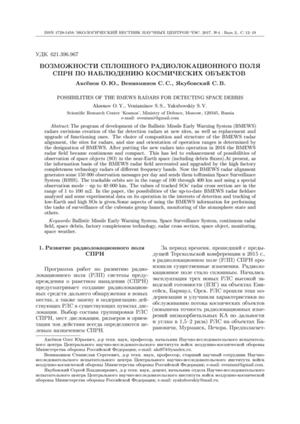Possibilities of the BMEWS radars for detecting space debris
UDC
621.396.967EDN
YMTQNSAbstract
The program of development of the Ballistic Missile Early Warning System (BMEWS) radars envisions creation of the far detection radars at new sites, as well as replacement and upgrade of functioning ones. The choice of composition and structure of the BMEWS radar alignment, the sites for radars, and size and orientation of operation ranges is determined by the designation of BMEWS. After putting the new radars into operation in 2016 the BMEWS radar field became continuous and compact. This has led to enhancement of possibilities of observation of space objects (SO) in the near-Earth space (including debris fluxes).At present, as the information basis of the BMEWS radar field are created and upgraded by the high factory completeness technology radars of different frequency bands. Now the BMEWS radar alignment generates some 150,000 observation messages per day and sends them toRussian Space Surveillance System (RSSS). The trackable orbits are in the range of 100 through 400 km and using a special observation mode - up to 40,000 km. The values of tracked SOs’ radar cross section are in the range of 1 to 100 m$^2$. In the paper, the possibilities of the up-to-date BMEWS radar field are analyzed and some experimental data on its operation in the interests of detection and tracking of low-Earth and high SOs is given.Some aspects of using the BMEWS information for performing the tasks of surveillance of the cubes ats group launch, monitoring of the atmosphere state and others.
Keywords:
Ballistic Missile Early Warning System, Space Surveillance System, continuous radar field, space debris, factory completeness technology, radar cross section, space object, monitoring, space weatherReferences
- Аксёнов О.Ю., Вениаминов С.С., Якубовский С.В. Возможности радиолокационных средств системы предупреждения о ракетном нападении по обнаружению космических объектов. В сб. "Околоземная астраномия-2015". Труды междунар. конф. 31 августа - 5 сентября 2015 г. п. Терскол. М.: Янус-К, 2015. С. 256-260. [Aksenov O.Yu., Veniaminov S.S., Yakubovskiy S.V. Vozmozhnosti radiolokatsionnykh sredstv sistemy preduprezhdeniya o raketnom napadenii po obnaruzheniyu kosmicheskikh ob"ektov [The radar capabilities of the missile attack warning system for the detection of space objects. In the collection]. In: "Okolozemnaya astranomiya-2015" Trudy mezhdunar. konf. 31 avgusta - 5 sentyabrya 2015 g. p. Terskol [Proc. of the Intern. conf. "Near-Earth astronomy-2015", August 31 - September 5, 2015, Terskol]. Moscow, Yanus-K Pub., 2015, pp. 256-260. (In Russian)]
- Zherebtsov G.A., Zavorin A.V., Kurkin V.I., Medvedev A.V., Potekhin A.P., Berngardt O.I., Vasiliev R.V., Kushnarev D.S., Lebedev V.P., Shpynev B.G., Khakhinov V.V. Irkutskin coherent scatter radar: history and perspectives // Proc. of the "International living with astarworkshop". Irkutsk, June 24-28, 2013, p. 25-26.
- Ratovsky K.G., Klimenko M., Klimenko V., Medvedev A.V., Alsatkin S.S., Oinats A.V. Comparison of height-diurnal electron density variations between Irkutsk Incoherent Scatter Radar and GSM TIP and IRI Models // Proc. of "Atmosphere, Ionosphere, Safety - 2016". V Int. Conf. Kaliningrad, 19-25 June, 2016: Kaliningrad, 2016. P. 482-486.
- Воздействие ракетно-космической техники на окружающую среду / Под ред. В.В. Адушкина, С.И. Козлова, М.В. Сильникова. М.: ГЕОС, 2016. 795 с. [Adushkin V.V., Kozlov S.I., Sil'nikov M.V. (eds.) Vozdeystvie raketno-kosmicheskoy tekhniki na okruzhayushchuyu sredu [The impact of rocket and space technology on the environment]. Moscow, GEOS Pub,, 2016, 795 p. (In Russian)]
- Вениаминов С.С., Якубовский С.В. Общая постановка задачи оптимизации группировки средств сложной системы вооружения // В сб. НИЦ РКО, ч. 2, 2013. С. 137-147. [Veniaminov S.S., Yakubovskiy S.V. Obshchaya postanovka zadachi optimizatsii gruppirovki sredstv slozhnoy sistemy vooruzheniya [General formulation of the task of optimizing the grouping of means of a complex armament system]. In: NITs RKO [Research Center Rocket Space Defense], pt. 2, 2013, pp. 137-147. (In Russian)]
Downloads

Downloads
Dates
Submitted
Accepted
Published
How to Cite
License
Copyright (c) 2017 Аксёнов О.Ю., Вениаминов С.С., Якубовский С.В.

This work is licensed under a Creative Commons Attribution 4.0 International License.


